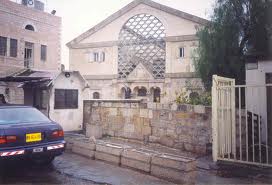Beit Hadassah Museum in Hebron
April 13th 2014
 Originally built in 1893, Beit Hadassah (The Hadassah House) originally operated under the name Chesed L’Avraham, serving as a free medical clinic for the Jews and Arabs of Hebron. The clinic thrived until it was destroyed during the Arab riots of 1929, but today it serves as a residence for Zionist settlers and as a museum that commemorates the original institution – as well as the story of the community surrounding it.
Originally built in 1893, Beit Hadassah (The Hadassah House) originally operated under the name Chesed L’Avraham, serving as a free medical clinic for the Jews and Arabs of Hebron. The clinic thrived until it was destroyed during the Arab riots of 1929, but today it serves as a residence for Zionist settlers and as a museum that commemorates the original institution – as well as the story of the community surrounding it.
During the uprising of 1929, the local pharmacist, rabbis and their families who lived nearby, were tortured and murdered. The remaining Jewish community evacuated Hebron for a short time but returned in 1931. When Arab riots began again in 1936, the Jews were evacuated by the British, who ruled pre-State Palestine at the time. Jewish homes were confiscated by Arabs, and Beit Hadassah became an Arab school. The building remained under Arab control until 1967.
Hebron, a city that had housed Jewish families since Biblical times, was returned to Jewish hands in 1967, as a result of Israel’s stunning successes in the Six Day War. However, it wasn’t until May 1979 that a small group of ten women and 40 children moved into the long-abandoned Beit Hadassah in the middle of the night. The Israeli government feared that Jews living in the heart of Hebron would inflame the local Arab population, but the women and children stayed in Beit Hadassah under primitive living conditions, separated from their husbands, for a year.
It took the deaths of six students from a nearby yeshiva during a terror attack to force the Israeli government to authorize the return of Jews to Hebron. The husbands of the original ten women moved into Beit Hadassah in 1979-80, and the government added two more stories of private apartments to the building. Today, the upper floors of Beit Hadassah are residential and include a small synagogue.
The lower floor of Beit Hadassah is a museum that tells the story of the Jewish return to Hebron and to Beit Hadassah. The first room in the museum highlights the history of the Jewish community in Hebron from the 16th century until the deadly Arab riots of 1929. Another room serves as a memorial to the people who were murdered in 1929. Tours of the Beit Hadassah Museum, peppered with personal stories of brave Jewish families who resettled Hebron, are offered by English-speaking members of the community.











